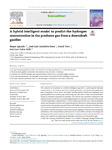Mostrar o rexistro simple do ítem
A hybrid intelligent model to predict the hydrogen concentration in the producer gas from a downdraft gasifier
| dc.contributor.author | Aguado, Roque | |
| dc.contributor.author | Casteleiro-Roca, José-Luis | |
| dc.contributor.author | Vera, David | |
| dc.contributor.author | Calvo-Rolle, José Luis | |
| dc.date.accessioned | 2022-07-12T08:58:21Z | |
| dc.date.available | 2022-07-12T08:58:21Z | |
| dc.date.issued | 2022-06-05 | |
| dc.identifier.citation | Aguado R, Casteleiro-Roca J-L, Vera D, Calvo-Rolle JL. A hybrid intelligent model to predict the hydrogen concentration in the producer gas from a downdraft gasifier. International Journal of Hydrogen Energy 2022;47:20755–70. https://doi.org/10.1016/j.ijhydene.2022.04.174 | es_ES |
| dc.identifier.issn | 0360-3199 | |
| dc.identifier.uri | http://hdl.handle.net/2183/31162 | |
| dc.description.abstract | [Abstract] This research work presents an artificial intelligence approach to predicting the hydrogen concentration in the producer gas from biomass gasification. An experimental gasification plant consisting of an air-blown downdraft fixed-bed gasifier fueled with exhausted olive pomace pellets and a producer gas conditioning unit was used to collect the whole dataset. During an extensive experimental campaign, the producer gas volumetric composition was measured and recorded with a portable syngas analyzer at a constant time step of 10 seconds. The resulting dataset comprises nearly 75 hours of plant operation in total. A hybrid intelligent model was developed with the aim of performing fault detection in measuring the hydrogen concentration in the producer gas and still provide reliable values in the event of malfunction. The best performing hybrid model comprises six local internal submodels that combine artificial neural networks and support vector machines for regression. The results are remarkably satisfactory, with a mean absolute prediction error of only 0.134% by volume. Accordingly, the developed model could be used as a virtual sensor to support or even avoid the need for a real sensor that is specific for measuring the hydrogen concentration in the producer gas. | es_ES |
| dc.description.sponsorship | Junta de Andalucía; 1381442 | es_ES |
| dc.description.sponsorship | Xunta de Galicia; ED431G 2019/01 | es_ES |
| dc.description.sponsorship | Ministerio de Universidades; FPU19/00930 | es_ES |
| dc.language.iso | eng | es_ES |
| dc.publisher | Elsevier | es_ES |
| dc.relation.uri | https://doi.org/10.1016/j.ijhydene.2022.04.174 | es_ES |
| dc.rights | Attribution-NonCommercial-NoDerivatives 4.0 International (CC BY-NC-ND 4.0) https://creativecommons.org/licenses/by-nc-nd/4.0/ | es_ES |
| dc.rights.uri | http://creativecommons.org/licenses/by-nc-nd/3.0/es/ | * |
| dc.subject | Biomass gasification | es_ES |
| dc.subject | Green hydrogen | es_ES |
| dc.subject | Artificial intelligence | es_ES |
| dc.subject | Machine learning | es_ES |
| dc.subject | Hybrid modeling | es_ES |
| dc.subject | Virtual sensor | es_ES |
| dc.title | A hybrid intelligent model to predict the hydrogen concentration in the producer gas from a downdraft gasifier | es_ES |
| dc.type | info:eu-repo/semantics/article | es_ES |
| dc.rights.access | info:eu-repo/semantics/openAccess | es_ES |
| UDC.journalTitle | International Journal of Hydrogen Energy | es_ES |
| UDC.volume | 47 | es_ES |
| UDC.issue | 48 | es_ES |
| UDC.startPage | 20755 | es_ES |
| UDC.endPage | 20770 | es_ES |
| dc.identifier.doi | https://doi.org/10.1016/j.ijhydene.2022.04.174 |
Ficheiros no ítem
Este ítem aparece na(s) seguinte(s) colección(s)
-
GI-CTC - Artigos [80]






